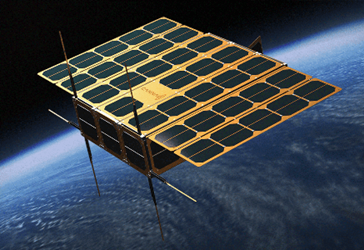NASA Publishes Peer-Reviewed Paper On Electromagnetic Drive Propulsion System
By Jof Enriquez,
Follow me on Twitter @jofenriq

A much-awaited, peer-reviewed paper on the electromagnetic (EM) drive, an esoteric propulsion system being developed by the National Aeronautics and Space Administration (NASA), has been published online in the American Institute of Aeronautics and Astronautics' Journal of Propulsion and Power.
British scientist Roger Shawyer in 1999 pioneered the concept of the EM Drive, a cone-shaped chamber where microwaves bounce back and forth to generate thrust. Some scientists are dismissive of such technology, since it violates Newton's third law of motion, which states that for every action, there is an equal and opposite reaction. In conventional propulsion systems, combusting rocket propellant pushes out superheated gases to move a spacecraft through space. The EM drive does not need rocket fuel to do this, instead utilizing bouncing microwaves to produce 1.2 millinewtons per kilowatt of thrust in a vacuum, as demonstrated by NASA's vacuum test.
"Thrust data from forward, reverse, and null suggested that the system was consistently performing at 1.2±0.1 mN/kW1.2±0.1 mN/kW, which was very close to the average impulsive performance measured in air," the scientists at NASA's Eagleworks Laboratories write in the paper titled Measurement of Impulsive Thrust from a Closed Radio-Frequency Cavity in Vacuum.
They pointed out that their test was performed primarily to establish that the EM Drive works, not to optimize performance. But they put in perspective the thrust generated by the device during this test, comparing it to existing conventional and alternative propulsion technologies.
"The current state-of–the-art thrust to power for a Hall thruster is on the order of 60 mN/kW60 mN/kW. This is an order of magnitude higher than the test article evaluated during the course of this vacuum campaign; however, for missions with very large delta-v requirements, having a propellant consumption rate of zero could offset the higher power requirements," the paper states. "The 1.2 mN/kW1.2 mN/kW performance parameter is over two orders of magnitude higher than other forms of “zero-propellant” propulsion, such as light sails, laser propulsion, and photon rockets having thrust-to-power levels in the 3.33–6.67 μN/kW3.33–6.67 μN/kW (or 0.0033–0.0067 mN/kW0.0033–0.0067 mN/kW) range."
The study explains the proposed underlying physics at work in the EM Drive test as a nonlocal hidden-variable theory, or pilot-wave theory. In contrast to the currently accepted Copenhagen interpretation of quantum mechanics – which states that particles do not have defined locations until they are observed – pilot wave theory suggests that particles do have precise positions at all times. Noting a resurgence in pilot wave theory in recent years, the NASA researchers suggests that it could help explain how the EM Drive produces thrust without appearing to propel anything in the other direction, according to Science Alert.
NASA knows that publishing a peer-reviewed paper that presents initial findings with plenty of experimental caveats could do little to assuage skeptics that the EM drive works. That's why, to confirm the researchers’ findings, NASA is launching an EM drive into space aboard a small satellite within the next six months. The satellite will deposit the EM drive into a decaying orbit, which only can be maintained if the drive functions properly.
If proven effective, NASA's EM drive could upend our understanding of quantum mechanics. In practical terms, it someday will maintain satellites in geostationary orbits, or make interplanetary travel more feasible. In fact, Shawyer claimed that the EM Drive could send humans to Mars in just 70 days, according to Tech Times.
